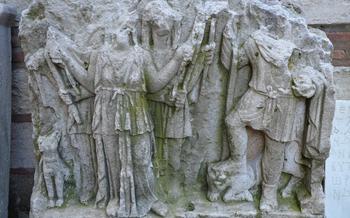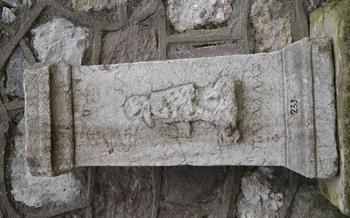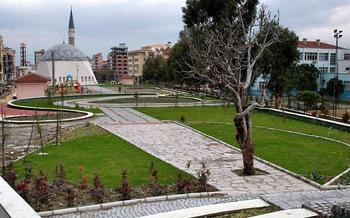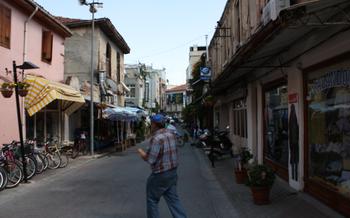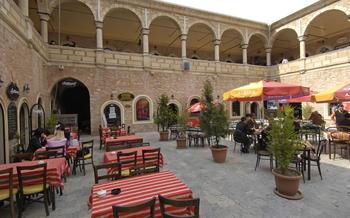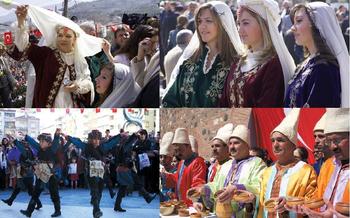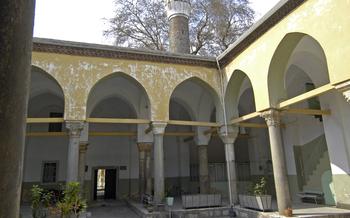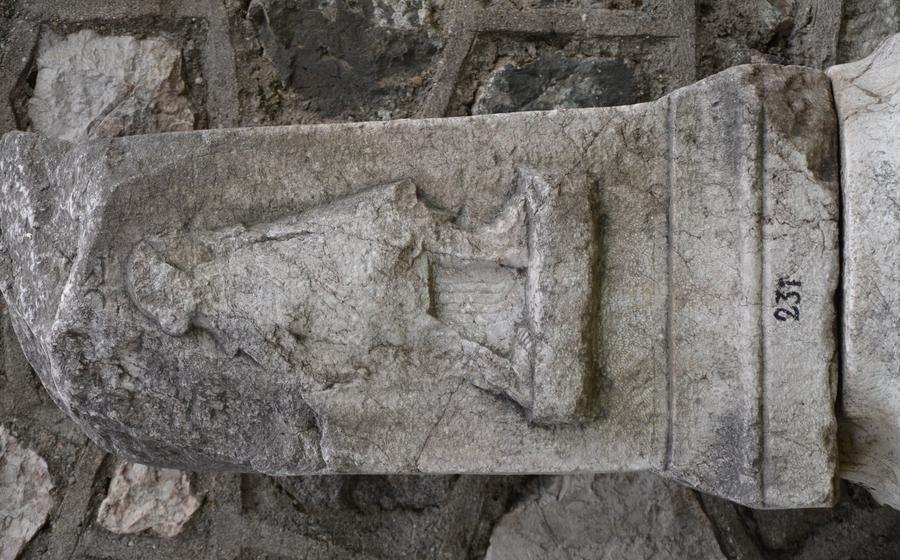
Manisa Old Bazaar
- Manisa Old Bazaar: A Historical Gem in the Heart of Turkey
- A Walk Through History
- Exploring the Bazaar's Districts
- Discover Local Handicrafts
- Indulge in Turkish Delights
- Haggling and Bargaining
- Manisa's Famous Products
- A Feast for the Senses
- Unveiling the Local Culture
- A Photographer's Paradise
- Manisa Old Bazaar Museum
- Planning Your Visit
- Nearby Attractions
- Accessibility and Transportation:
- Insider Tip
Manisa Old Bazaar: A Historical Gem in the Heart of Turkey
In the heart of Turkey, nestled within the vibrant city of Manisa, lies a hidden gem that transports visitors back in time – the Manisa Old Bazaar. With a history that spans over several centuries, this bustling marketplace has played a pivotal role in the city's economic and cultural development. Its unique architectural features, vibrant atmosphere, and array of local handicrafts and souvenirs make it a must-visit destination for travelers seeking an authentic Turkish experience.
The Manisa Old Bazaar is a testament to the city's rich cultural heritage. Its labyrinthine alleys, lined with traditional Ottoman-style shops and stalls, create a mesmerizing ambiance that captivates visitors from the moment they step inside. The air is filled with the tantalizing aromas of freshly brewed Turkish coffee, fragrant spices, and delectable pastries, creating a sensory feast that heightens the overall experience.
A Walk Through History
The Manisa Old Bazaar boasts a rich and storied past, with its origins tracing back to the ancient Lydian civilization. During the Roman and Byzantine eras, the bazaar flourished as a trading hub, connecting East and West. Over the centuries, it has undergone various transformations, reflecting the diverse cultural influences that have shaped Manisa. In the Ottoman period, the bazaar reached its zenith, becoming a bustling center of commerce and craftsmanship. Guilds of artisans, each specializing in a particular craft, established their workshops within the bazaar, creating a vibrant and diverse atmosphere. The bazaar's strategic location along trade routes further contributed to its economic prosperity. Throughout history, the Manisa Old Bazaar has played a pivotal role in the cultural and economic life of the city. It has been a place of exchange, not just of goods but also of ideas and traditions. Stories and legends passed down through generations speak of the colorful characters and remarkable events that have unfolded within its walls.
Exploring the Bazaar's Districts
The Manisa Old Bazaar is not just a marketplace; it's a labyrinth of interconnected streets and districts, each one specializing in a different type of goods. From textiles to jewelry, spices, and beyond, the variety of products on offer is staggering.
In the textile district, you'll find rows of shops selling colorful fabrics, traditional Turkish scarves, and embroidered garments. The air is filled with the sound of sewing machines and the chatter of shoppers bartering for the best prices.
In the jewelry district, the glimmering storefronts showcase an array of gold, silver, and precious stones. Artisans meticulously craft intricate pieces, from delicate necklaces to ornate earrings, right before your eyes.
The spice district is a feast for the senses, with vibrant colors and heady aromas filling the air. Vendors display mounds of spices, from vibrant red paprika to fragrant saffron, while the scent of freshly ground coffee beans wafts through the streets.
As you wander through the bazaar, keep an eye out for hidden treasures tucked away in the smaller shops and ateliers. You might stumble upon a craftsman creating handmade pottery, a weaver working on a traditional rug, or a leatherworker crafting unique bags and accessories.
Exploring the different districts of the bazaar is like embarking on a journey through time. Each street tells a story of craftsmanship, tradition, and the vibrant culture of Manisa.
Discover Local Handicrafts
Manisa Old Bazaar is a treasure trove of traditional Turkish crafts and techniques, showcasing the skills and artistry of local artisans. From intricate carpets and pottery to finely carved woodwork, each piece is a testament to the rich cultural heritage of the region.
In the textile section, you'll find an array of colorful carpets, each hand-knotted with intricate designs and patterns. The vibrant hues and unique motifs reflect the nomadic traditions of Anatolian tribes, telling stories of their travels and heritage.
Pottery enthusiasts will delight in the exquisite ceramics and pottery crafted by local artisans. From delicate teacups to ornate vases, each piece is a masterpiece of craftsmanship, showcasing the potter's skill and attention to detail.
Woodwork, a prominent art form in Manisa, is showcased through intricate carvings and decorative pieces. From finely inlaid furniture to decorative objects, the intricate designs and patterns add a touch of elegance and sophistication to any home.
These unique souvenirs are not just beautiful but also carry the essence of Turkish culture and tradition. By purchasing these handmade items, you not only take home a piece of Manisa but also support the livelihoods of local artisans, ensuring the continuation of these age-old crafts.
Indulge in Turkish Delights
The Manisa Old Bazaar is a culinary paradise, offering a tantalizing array of traditional Turkish sweets and pastries that are sure to delight your taste buds. From the iconic lokum (Turkish delight), with its soft, chewy texture and vibrant colors, to the rich and flaky baklava, made with layers of filo pastry, nuts, and honey, the bazaar is a haven for those with a sweet tooth.
Strolling through the narrow lanes, you'll be tempted by the aromas of freshly baked pastries wafting from the stalls. Sample the traditional "katmer," a crispy, layered pastry filled with cheese or minced meat, or indulge in the sweet "tulumba," a deep-fried dough soaked in syrup. For a refreshing treat, try the "dondurma," a unique Turkish ice cream with a chewy texture and a variety of flavors.
Don't miss the opportunity to savor the local street food, a culinary adventure in itself. From grilled kebabs and pide (Turkish pizza) to gözleme (stuffed flatbread), the bazaar offers a taste of authentic Turkish cuisine that will leave you craving for more. Embrace the vibrant culinary scene and embark on a journey of flavors that will tantalize your senses and create lasting memories.
Haggling and Bargaining
When shopping in the Manisa Old Bazaar, haggling and bargaining are as much a part of the experience as the colorful sights and aromatic scents. It's a cultural practice that adds a touch of excitement and interaction to the shopping process.
To get the best prices, start by offering a lower price than the initial asking price. Be prepared to negotiate and go back and forth until you reach a mutually agreeable price. Remember, haggling is a friendly and respectful process, so always be polite and maintain a smile.
Pay attention to the seller's body language and tone of voice to gauge their willingness to negotiate. If they seem hesitant or unwilling to lower the price, don't be afraid to walk away and try your luck at another shop.
Haggling and bargaining are not just about getting a good deal; it's also about the cultural exchange and interaction with the locals. Embrace the process, have fun, and don't be afraid to make an offer!
Manisa's Famous Products
Manisa Old Bazaar is renowned for its unique products and specialties that reflect the city's rich history and culture. Among these, dried figs hold a special place. Manisa's figs are known for their exceptional sweetness, plump texture, and distinct flavor. They are carefully harvested and sun-dried to create a natural and nutritious snack.
Another famous product is the Manisa Mesir Paste, a traditional Turkish delight made from a blend of spices, nuts, and sugar. This flavorful paste has medicinal properties and is believed to have healing effects. It is often used as a natural remedy for various ailments and is a popular souvenir among visitors.
Manisa's textiles are also highly regarded for their intricate designs and vibrant colors. From traditional Turkish carpets and kilims to finely woven fabrics and clothing, the bazaar offers a diverse selection of handmade textiles. These products showcase the skill and craftsmanship of local artisans and make for unique and authentic souvenirs.
A Feast for the Senses
Manisa Old Bazaar is a feast for the senses, a vibrant tapestry of colors, aromas, and sounds that captivates visitors from the moment they step through its ancient gates. The vibrant colors of the textiles, carpets, and handicrafts create a kaleidoscope of hues that dance in the sunlight. The air is filled with the aromatic scents of spices, perfumes, and freshly baked goods, tantalizing the senses and creating an irresistible allure. The sounds of haggling, music, and laughter mingle in the air, creating a lively and energetic atmosphere that is both enchanting and contagious. This sensory overload is a testament to the vibrant culture and rich history of the bazaar, inviting visitors to immerse themselves in a world that is both familiar and exotic.
Unveiling the Local Culture
Venturing into the heart of the Manisa Old Bazaar is not just a shopping expedition; it's a journey into the very essence of Turkish culture and traditions. As you wander through the vibrant alleys, you'll encounter friendly locals who are more than happy to share insights into their way of life. Observe the shopkeepers engaging in lively conversations, the women bargaining with a twinkle in their eyes, and the children running around, their laughter echoing through the bazaar. It's a chance to witness daily life unfold, to understand the customs and traditions that shape this vibrant city. Whether it's sipping on a cup of traditional Turkish coffee or sharing a meal with a local family, every interaction offers a glimpse into the warm and welcoming nature of the Turkish people.
A Photographer's Paradise
The Manisa Old Bazaar is a visual feast, a photographer's paradise waiting to be explored. The vibrant colors of the traditional Turkish carpets, the intricate designs of handmade pottery, and the aromatic spices create a kaleidoscope of hues that beg to be captured. Wander through the narrow streets and capture the essence of the bazaar, with its bustling crowds, friendly vendors, and hidden corners.
Photograph the locals going about their daily lives, the smiles on their faces, and the interactions that tell stories of a rich culture. Street photography comes alive in the bazaar, as every corner offers a unique perspective and a chance to document the vibrant energy of this historic marketplace. Share your travel experiences through your lens, letting the world see the beauty and authenticity of the Manisa Old Bazaar.
Manisa Old Bazaar Museum
Within the vibrant heart of the bazaar, the Manisa Old Bazaar Museum stands as a testament to the rich history and cultural significance of this ancient marketplace. Step inside to embark on a journey through time, where interactive displays and educational panels narrate the bazaar's evolution over the centuries. Discover the stories behind the exquisite handicrafts, traditional practices, and unique products that have shaped the identity of the Manisa Old Bazaar. Immerse yourself in the tales of the artisans, merchants, and customers who have brought life to this bustling hub for generations. The Manisa Old Bazaar Museum is an essential stop for anyone seeking a deeper understanding of the bazaar's heritage and its profound impact on the cultural tapestry of Turkey.
Planning Your Visit
When planning your visit to the Manisa Old Bazaar, consider the following tips for an enjoyable and rewarding experience:
Best Time to Visit:
- Aim for the spring (April-May) or autumn (September-October) months to avoid the scorching summer heat and the cold winter weather.
- If possible, plan your visit for a weekday to escape the weekend crowds and have a more relaxed shopping experience.
- Arrive early in the morning when the bazaar is less crowded, and the shopkeepers are more likely to offer better deals.
Navigating the Crowds:
- The bazaar can be bustling and crowded, especially during peak tourist season. Be prepared for narrow streets and lots of foot traffic.
- Be mindful of your surroundings and keep an eye on your belongings to avoid pickpockets.
Dress Code and Cultural Considerations:
- Dress modestly and respectfully, as the bazaar is located in a conservative area. Avoid wearing shorts, tank tops, or revealing clothing.
- Remember to greet the shopkeepers and locals with a friendly "Merhaba" (Hello) and "Teşekkür ederim" (Thank you).
Making the Most of Your Time:
- Set aside at least half a day to fully explore the bazaar and soak in its vibrant atmosphere.
- Take breaks at one of the many cafes or teahouses to rest your feet and people-watch.
- Don't be afraid to get lost in the maze-like streets – you might stumble upon hidden gems and unique finds.
Nearby Attractions
While immersing yourself in the charm of the Manisa Old Bazaar, take the opportunity to explore other fascinating attractions that Manisa has to offer. Just a short distance away, you'll find the Manisa Museum, a treasure-trove of archaeological wonders and historical artifacts that provide a deeper insight into the region's rich past. Don't miss the Ulu Mosque, an architectural masterpiece renowned for its stunning dome and intricate tilework, a testament to the city's Islamic heritage.
Venture beyond the urban landscape and embrace the natural beauty of Spil Mountain, a picturesque haven located just a stone's throw from the city center. Ascend to its peak and be rewarded with breathtaking panoramic vistas, a feast for the eyes and a soothing balm for the soul.
By combining these diverse experiences, you'll create a well-rounded travel itinerary that captures the essence of Manisa's cultural heritage, architectural marvels, and captivating natural surroundings.
Accessibility and Transportation:
The Manisa Old Bazaar is conveniently accessible by public transportation, making it easy for visitors to explore without the hassle of driving. Several bus lines stop near the bazaar, and the Manisa train station is just a short walk away. For those driving, there are several parking options available, including public parking lots and on-street parking. The bazaar is also accessible for visitors with disabilities, as many of the streets are wheelchair-friendly and there are ramps and elevators in some of the buildings. To ensure a smooth and hassle-free visit, it's a good idea to plan your route in advance and wear comfortable shoes as you will be doing a lot of walking.
Insider Tip
Beyond the bustling main streets, the Manisa Old Bazaar hides hidden gems waiting to be discovered. Venture into the smaller alleys and side streets to uncover unique shops and workshops where artisans create their masterpieces. Look for the unobtrusive signs that mark these hidden treasures, often tucked away from the crowds. Here, you'll find one-of-a-kind handicrafts, textiles, and souvenirs that truly reflect the soul of Manisa.
For the best deals and authentic products, engage with the friendly locals. Ask questions, learn about their crafts, and don't be afraid to haggle. The shopkeepers are often willing to offer discounts if you show genuine interest and respect for their work.
After exploring the bazaar, satisfy your taste buds with local delicacies. Ask for recommendations from the locals or follow your nose to the enticing aromas wafting from nearby restaurants and cafes. Indulge in traditional Turkish dishes, freshly baked pastries, or a refreshing glass of tea while soaking in the vibrant atmosphere of the bazaar.
Remember, the Manisa Old Bazaar is a living, breathing entity that offers a unique experience with each visit. Embrace the chaos, the colors, and the sounds, and let your senses guide you as you explore this enchanting marketplace. Whether you're a seasoned traveler or a first-time visitor, the Manisa Old Bazaar promises an unforgettable adventure that will leave you with cherished memories and a newfound appreciation for Turkish culture and traditions.

